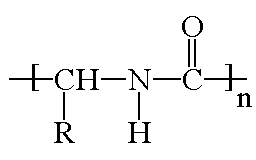Polymers and Walruses

No, this is not a love story even if it sounds like one.
The walrus is another mammal that was, and still is, hunted
for raw materials such as their meat and skin. Their ivory tusks are the
most valuable because they are soft enough to be carved into
practically anything, and yet sturdy enough to keep for a really long
time. The reason for this longevity is because they are made of
protein. The same kind of protein that
is found in our bodies such as hair and fingernails. Protein is a
natural polymer.
I'm sure you're getting tired of seeing it, but protein looks like this:

It even looks like its tough, doesn't it?
 The tusks were carved into jewelry. Now, some of this type of
jewelry still exists but we also have the capability to make jewelry with
polymers. Plastics are used to make many
different kinds of jewelry. Some other types of polymers used in everyday
products that you use are Teflon
(AKA: Polytetrafluoroethylene), nylon, acrylic based polymers in paints and coatings (polyacrylates), and
of course PVC or poly(vinyl chloride)
used in white plastic plumbing pipe.
The tusks were carved into jewelry. Now, some of this type of
jewelry still exists but we also have the capability to make jewelry with
polymers. Plastics are used to make many
different kinds of jewelry. Some other types of polymers used in everyday
products that you use are Teflon
(AKA: Polytetrafluoroethylene), nylon, acrylic based polymers in paints and coatings (polyacrylates), and
of course PVC or poly(vinyl chloride)
used in white plastic plumbing pipe.
The basic chemical structures of these polymers looks like:
Nylon Teflon 
Polyacrylate Poly(vinyl chloride)
 The intestines of walruses are made of
a water resistant material. They were used to make raincoats by the early hunters.
Now the world uses a polymer mixture based on poly(vinyl chloride) and plasticizers or softeners to make raincoats.
This material is easier to obtain, cheaper, and a lot less
messy.
The intestines of walruses are made of
a water resistant material. They were used to make raincoats by the early hunters.
Now the world uses a polymer mixture based on poly(vinyl chloride) and plasticizers or softeners to make raincoats.
This material is easier to obtain, cheaper, and a lot less
messy.
One of the non-polymer materials previously obtained from walruses is the blubber used to make oil. One of the main components, a fatty acid called Eicosapentaenoic acid, is easily synthesized today. Blubber oil can also be found in whales, and sharks, but again, there's no need to kill these animals for products that we can so easily make ourselves.
Return to the Mammal Show
Return to the Polyquarium


